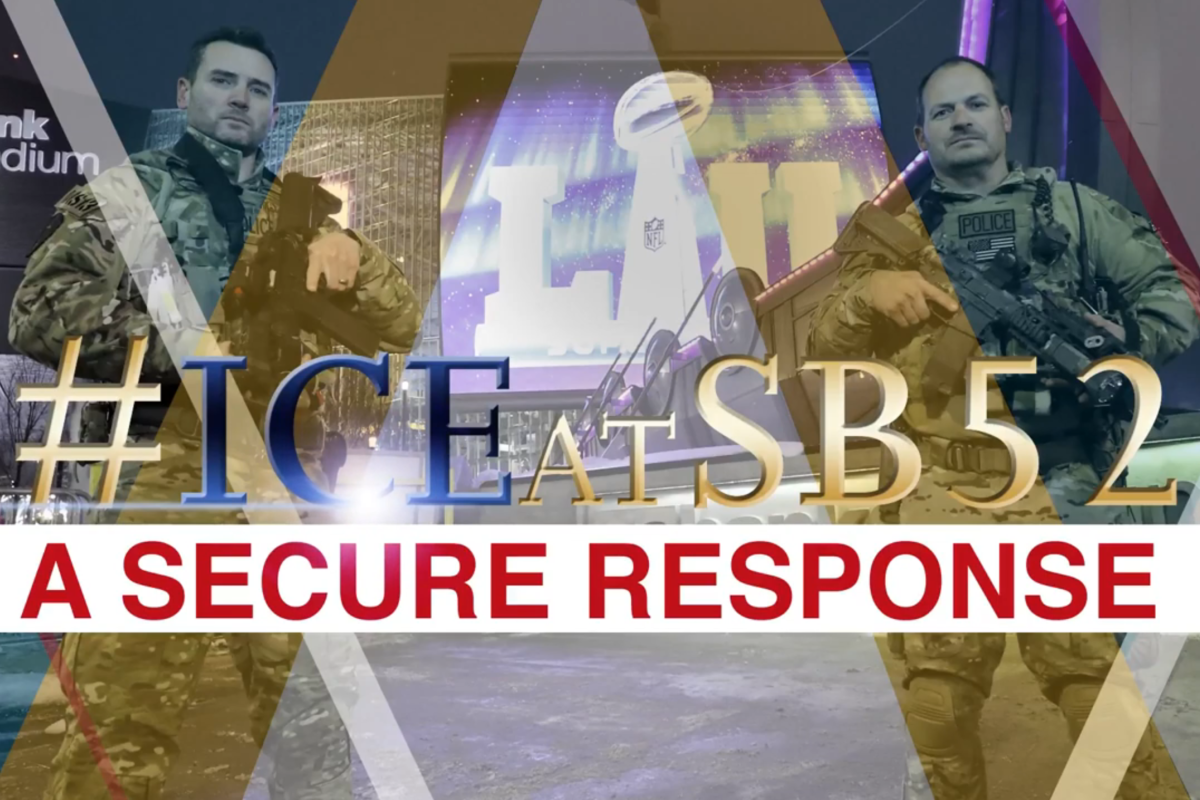With a pair of press conferences and a one-minute video posted on YouTube this week, U.S. Immigrations and Customs Enforcement, aka ICE, kicked off its annual Super Bowl tradition: turning its inexplicable presence at the big game into a steady stream of marketing material. The Super Bowl, deemed by Homeland Security as a potential target for terrorism, enlists numerous government agencies for support, and as a participating partner, ICE seizes the opportunity for self-promotion. Nearly half of the videos that the agency posted in 2018 on its YouTube page detailed Super Bowl-related work, such as confiscating counterfeit merchandise.
Given ICE’s authoritarian reputation, it’s easy to understand why the agency might find value in advertising its more benign work. Other videos on ICE’s social channels, though, more readily remind viewers of the agency’s primary identity as a violent instrument in America’s mass deportation regime. (According to recent reports, ICE detains over 44,000 people daily and deported 256,085 people in the 2018 fiscal year.) Tracking down fugitives, protecting victims of violent crimes that happen to be committed by immigrants: these are the types of stories the agency’s video team likes to tell along with tales of wiping bootleg Super Bowl shirts from the streets. The low-polish clips are soundtracked by ominous synth drones and martial drums, or sentimental guitar wandering, or self-serious documentary-style strings. The music choices are made possible by the production music library Killer Tracks, a subsidiary of Universal Music Publishing Group, which has a five-year contract with ICE, currently worth $9,425, for “licensed music tracks used for agency video production,” according to publicly available federal procurement records first reported by Sludge.
Shazam’ing videos on ICE’s YouTube and Facebook pages reveals dozens of compositions from the Killer Tracks collection, which offers thousands of albums of background music, some of which were created by songwriters and musicians who work with the biggest pop stars on the planet. The agency used a funky saxophone beat by Charles “Chizzy” Stephens—who has produced for Jennifer Lopez, Justin Bieber, and others—to soundtrack a gun-heavy video titled “A Super Week“ that recaps the agency’s work seizing counterfeit merch during last year’s Super Bowl. It used a dubstep-y loop by Shawn Mendes’ music director Zubin Thakkar to dramatize a look at the agency’s “Mobile Command” during the same event. Most of the musicians, though, are more anonymous, like indie rock artist Taylor Locke, whose track “Flood Blockade” scores a video called “ICE at Super Bowl 52: Spotting the fakes,” or composer Evan Beigel, whose track “Empower These Shores” was used in a video titled “ICE at Super Bowl LI: Fighting Trafficking.”
The musicians who contribute to Killer Tracks are independent contractors who don’t control how their work is used by clients, or which clients choose to use it—an arrangement similar to that of other media libraries, such as Getty Images. (The popular photo service also had a contract with ICE, worth $5,004, which expired in September.) But given recent actions by employees at other companies to protest their employers’ ICE contracts, I was curious to ask KillerTracks contributors their thoughts on their music being used by the agency executing the worst impulses of the Trump administration.
Both Locke and Beigel use Killer Tracks royalties to support their music careers, and emphasized a distinction between their actual artistic output and their work for the company. Locke first contributed in 2016, nearly two decades into a career that began in high school as founding member of the modestly successful major label power-pop band Rooney. Since the group’s disbanding, he’s formed two other bands, released an album of solo material, and opened a recording studio in Los Angeles, but never again approached the charts. He told me contributing to Killer Tracks is a “great way for independent self-employed musicians in this climate to generate extra income.”
Until I reached out a few weeks ago, Locke had no idea his music was featured in ICE propaganda. He was surprised by the placement—he rarely sees where his contributions land, citing a makeup infomercial as a past instance—and defensive about questions of responsibility. “What happens with the music after I submit it to Killer Tracks is specifically not my right or my business,” Locke said. He added, “I do think that it’s important to potentially be more protective of where things go and what they represent.”
Beigel also questioned his ability to judge Killer Tracks placements, saying, “Who am I to say who’s gonna buy it, if I’m willing to put it out there to make a living?” He expressed his disappointment that the company might work with bad actors. “I wish that that wasn’t even a conversation, you know? That people would just do the right thing,” he said. Like Locke, he, too, was previously unaware of the ICE placement.
Anna Maria Hall, head of sales and marketing for Killer Tracks, said the company has worked with government clients since 1998, but that these clients do not comprise “a significant amount of our business.” Killer Tracks has active contracts with 10 U.S. agencies, including the Navy, Federal Bureau of Investigations, and National Institutes of Health, currently worth $104,330 in total. Hall added that Killer Tracks maintains policies regarding “proper use” of content that include “prevention of the music’s use on certain kinds of media,” but did not say what type of media might violate the policies. The company also did not respond to questions about whether it has ever rejected any prospective clients.
For musicians, the ethical implications of these arrangements are muddy. Contractors providing music that is generic by its very definition may have less leverage in protesting their proximity to ICE, whether by withholding labor or by petitioning, than Microsoft employees who pushed back on their own company’s contract with ICE. In an industry that makes it increasingly difficult for most musicians to make a living, it’s hard to fault them for not doing so. (Even big names like Ennio Morricone and Chuck D have music available on Killer Tracks.)
Beigel acknowledged the moral tension. “Regardless of my own beliefs, I’ve really learned how to separate the music that I sell to Killer Tracks from my own personal music as an artist. I kind of had to force myself to do that,” he said. Meanwhile, the ICE YouTube video featuring Beigel’s music has fewer than 500 views, and many other clips on the agency’s channel don’t break three or sometimes even two figures. Any Killer Tracks contributor who feels conflicted about ICE can at least take comfort that almost no one’s watching.





